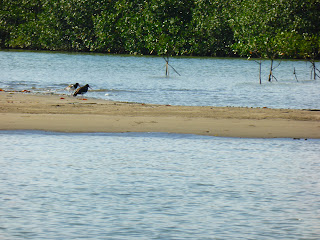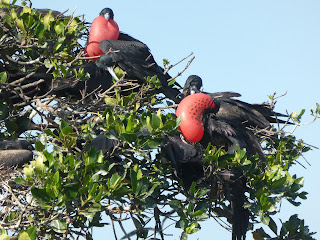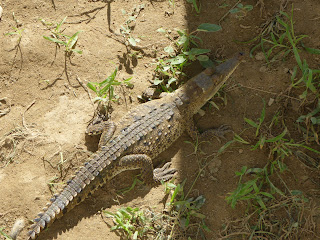I arrived early and first stop was the observation platform
 |
| There was plenty of bustle down at the dock |
 |
| This guy was cleaning and selling his fish right on the slipway |
 |
| This little fellow was making a lot of noise under the decking - hope mum was out looking for breakfast |
 |
| Similar to the boat I had all to myself |
 |
| We weaved our way through the fishing fleet |
 |
| Observation platform from the water |
 |
| Crow perched on a boat |
 |
| Fisherman ferrying ice out to the fishing boat |
 |
| Many boats had nesting pelicans |
 |
| Fishing boats moored up near where I left my bike - the ones at the rear are beached for repairs |
 |
| Turkey Vulture |
 |
| Isla Hueso de Ballena (Whalebone island) - unfortunately commercialisation has arrived here too, so I declined the opportunity to land here (it looked deserted anyway!) |
 |
| Lots of bars and restaurants as this is a popular weekend retreat for residents of Tumbes |
 |
| The open sea - we turned here as the boat was not suitable for the high sea |
 |
| Puerto Pizarro from the bay's entrance |
We headed deeper into the bay, which is a protected habitat for both the nesting birds and the mangroves, and it is a nursery for dozens of fish species, so fishing is also prohibited in the bay. I could see birds flying in the distance, and was told we were nearing Isla das Pajaros
 |
| Approaching the nesting sites |
 |
| Oystercatchers on a sandbank |
 |
| The Frigate birds were nesting in the mangroves |
 |
| The first roosts we saw were Cormorants |
 |
| ... and there were also Pelicans in the trees |
 |
| Though most were Magnificent Frigate Birds |
 |
| The males were puffing out their red throat pouches for attention |
 |
| There was also the occasional White Egret ... |
 |
| ... and Peruvian Boobies |
Our boat went between two small islands of mangroves and you could almost reach out and touch the birds - it was an incredible experience.
 |
| The Frigates seemed to nest close together in certain areas, which I suppose gave them protection from predation. |
 |
| Another Cormorant and Booby roost - these didn't seem to be nesting here - maybe it was not the breeding season for them |
 |
| All round the sky was filled with, predominantly, Frigate Birds |
 |
| Flying just over our heads ... |
 |
| ... but seemingly disinterested in our presence |
 |
| Grey Heron |
 |
| It was really peaceful slowly cruising through the mangroves |
 |
| This area is protected and covers almost 3,000 hectares (7,400 acres) |
 |
| We eventually turned down a small side river |
 |
| Close-up of the root system |
turning down a small river to the crocodile farm. I was actually dreading this part of the trip as I had read some bad reviews about the farm, and also knowing how generally in South America animals are not well treated, though a lot of this is due to lack of funding.
 |
| There was another boat already at the farm |
 |
| Tumbes Crocodile Farm - the idea is to protect the American Crocodiles and then release them back into the Tumbes river, where hopefully they can build a sustainable population |
 |
| American Crocodile |
 |
| The crocodiles appeared to be separated by age |
 |
| ... and though some pens appeared a little overcrowded |
 |
| ... they did seem well fed, and the water was clean |
 |
| This one was showing off |
 |
| Tumbes in the distance |
 |
| The pens were pretty featureless, but in the wild they spend a lot of time sunning themselves too |
 |
| This was a juvenile |
 |
| There was shade and water in all the pens |
 |
| A couple of larger crocs |
 |
| Not much free space here |
 |
| On the whole I was not as disappointed as I thought I would be |
Soon it was time to head back to Puerto Pizarro
 |
| We followed the other boat out |
 |
| The bay was pretty deserted, but looked very inviting |
 |
| More pelicans roosting on teh fishing boats |
 |
| We weaved our way back through the anchored boats |
 |
| Pelicans not far away from the fishermen repairing their nets |
 |
| This one was doing his figurehead impression |

